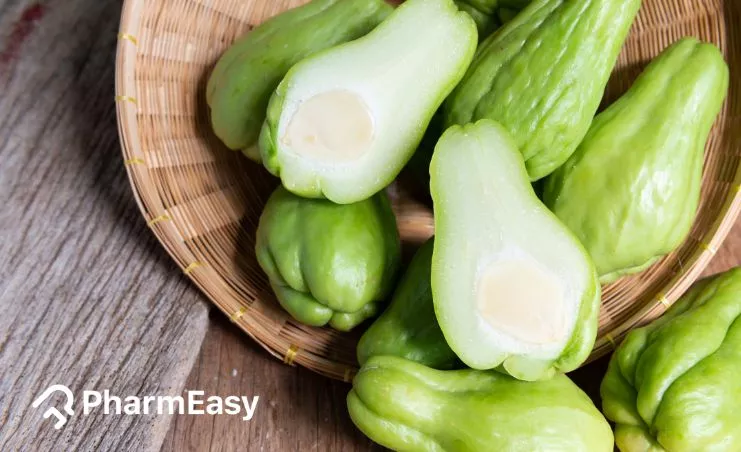Chayote: Uses, Benefits, Side Effects & More
By Mansi Shah +2 more

Get,

to manage your symptom
Get your,


4 Cr+ families
benefitted

OTP sent to 9988776655



You’ve successfully subscribed to receive
doctor-approved tips on
Whatsapp

Get ready to feel your best.

Hi There,
Download the PharmEasy App now!!


Register to Avail the Offer
Send OTPBy continuing, you agree with our Privacy Policy and Terms and Conditions

Hi There,
Sign up on PharmEasy now!!
Trusted by 4 crore+ families

OTP sent to 9988776655



You have unlocked 25% off on medicines




Code: NU25
By Mansi Shah +2 more
Table of Contents
Chayote, scientifically known as Sechium edule, is a climbing plant belonging to the Cucurbitaceae family. Initially grown in Mexico and Guatemala, it was later introduced to the United States, Europe, Africa, China, and South-Asian countries. Nowadays, it is grown throughout the world in tropical and subtropical areas1.
There are two major varieties of chayote plants, namely, the commercial variety and the wild type.1 Commonly chayote is known by different names such as vegetable pear, cho cho, chow-chow, sayote, pear squash, christophene, chuchu, guisquil, and iskus2.

The plant’s edible parts are its fruits, stems, leaves, and roots. Chayote fruits are bright green and pear-shaped. There are many medicinal benefits of chayote owing to the bioactive compounds such as sterols, cucurbitacins and polyphenol compounds present in it1.
Chayote has high nutrient value and is loaded with essential vitamins, minerals, fibers, and antioxidants. According to the US Department of Agriculture, the nutritional value of 100g of Chayote is as follows4:
Existing studies suggest that chayote may offer the following potential benefits as a part of overall health:
Diets high in saturated fats can lead to fat build-up in the arteries, making it harder for the heart to pump blood efficiently. Chayote is low in fat and contains fibre and antioxidants, which may support heart health by helping to manage cholesterol levels as part of a balanced diet.
A study8 found that extracts of Chayote help in the treatment of heart diseases by influencing the function of the smooth muscles of the arteries. Additionally, chayote is rich in fibres, and studies have shown that dietary fibres may prevent heart diseases9. However, if you have a heart condition, don’t replace your medications with chayote. It is best to consult a doctor and seek treatment accordingly.
Diabetes is a medical condition in which blood has high levels of sugar. A review study found that the natural antioxidants in the vegetables like chayote may maintain glucose balance in the body and reduce sugar spikes after meals10. Additionally, the rich fibrous content of the chayote may help in managing blood sugar levels by slowing down the absorption of carbohydrates, resulting in reduced blood sugar levels after eating. The chayote extracts may reduce blood sugar levels3. Consult a doctor to know if consuming chayote is right for you in supporting diabetes management.
Women require specific nutrients like folate, iron, calcium, and essential vitamins to support a healthy pregnancy2. Chayote is a good source of folate, a vital nutrient during pregnancy that supports the healthy development of the baby’s brain and spinal cord. Research has shown that adequate folate intake may help reduce the risk of premature delivery and neural tube defects. Including chayote as part of a balanced diet may contribute to a healthy pregnancy. It can also help in lowering blood pressure in pregnant women; however, it is important to consult a healthcare professional rather than relying on self-medication11,12.
Cancer is a medical condition where the body’s cells abnormally multiply, affecting its normal functioning. A study5 found that chayote may inhibit the multiplication of cancerous cells and promote cell death. Studies13 have also found that chayote fruits may help in the treatment of acute myeloid leukemia. Additionally, the chayote leaf extracts may inhibit the multiplication of breast cancer cells14. However, if you suspect cancer, instead of self-medicating, you should consult a doctor to understand chayote leaves’ health benefits and seek treatment accordingly.
Antioxidants may protect the body against cellular damage and reduce inflammation. A study has shown that free radicals may damage the body cells, reduce the body’s functioning over time, and accelerate ageing. Studies15 show that antioxidants from chayote can protect the cells from harmful effects of UV rays, reduce cell damage, and slow down the signs of ageing16. Chayote is rich in antioxidants and vitamin C and may benefit the skin by promoting collagen production that may reduce the visible signs of ageing such as wrinkles, fine lines, and pigmentations1. However, you should always consult a doctor instead of self-medicating to get chayote leaves benefits.
Fatty liver disease occurs when excessive fat accumulates in the liver, affecting its normal function. Some studies have indicated that extracts from chayote may help protect liver tissue by reducing fat deposition. While these findings are promising, further research is needed, and dietary changes should always be discussed with a healthcare professional7. More research is required to understand how chayote squash benefits liver functioning. If you have a fatty liver, you should consult a doctor instead of self-medicating.
Other potential uses of chayote squash vegetable are as follows:
In traditional medicine, decoctions made from the leaves or fruit of chayote have been used for their potential diuretic properties. They have been traditionally applied to help relieve burning sensations during urination, support kidney health, and manage certain respiratory discomforts. However, these uses are based on traditional practices, and scientific evidence is limited. Anyone considering such remedies should consult a qualified healthcare professional8.
Chayote fruit is rich in vitamin A and E, both of which are essential for normal bodily functions. Vitamin A may support good vision, reproductive health, and the health of your blood, while vitamin E might be crucial for maintaining a healthy brain and glowing skin19.
Dr. Siddharth Gupta, B.A.M.S, M.D (Ayu)
Chayote can be used in the following ways:
You must consult a qualified doctor before taking any herbal supplements. Do not discontinue or replace an ongoing treatment of modern medicine with an ayurvedic/herbal preparation without consulting a qualified doctor.
No significant side effects have been scientifically documented in relation to the moderate consumption of chayote as part of a normal diet. It is well-tolerated by most people and is not known to cause adverse effects when properly prepared and consumed in typical amounts.
General precautions must be followed while consuming chayote. Here is a list of a few precautions.
Also Read: Ber Fruit (Jujube): Uses, Benefits, Side Effects & More!
There is not enough evidence on the interaction of the chayote extracts with other drugs. Further studies are required. Therefore, you must consult your doctor if you are on any other medication before consuming chayote.
There is a traditional belief that chayote leaves may help in the natural elimination of kidney stones. They have been used in some cultures with the view that their properties might support the breakdown of kidney stones. However, scientific research on this specific use is currently limited19. It is important to consult a medical professional for proper diagnosis and treatment of kidney stones rather than relying solely on traditional remedies.
Dr. Rajeev Singh, BAMS
Chayote recipes can be enjoyed in both savoury and sweet dishes. Here are a few chayote recipe ideas to inspire your culinary creativity:
Make a refreshing salad by thinly slicing chayote and mixing it with your favourite vegetables, such as tomatoes, onions, and bell peppers. Toss the salad with a zesty vinaigrette dressing for a crisp and healthy side dish.
Stuffed chayote is a flavourful and satisfying dish in which chayote halves are filled with a seasoned mixture, commonly containing ground meat, vegetables, and herbs. The filled chayotes are then baked or cooked until tender, allowing the mild flavour of the vegetable to blend beautifully with the savoury stuffing. This dish serves as a hearty, protein-rich main course and a wholesome addition to any meal.
Cut chayote into strips, season with your preferred spices, and bake or air-fry for a nutritious alternative to traditional potato fries. Sliced chayote is seasoned and baked until it becomes crisp and golden brown, offering a delightful snack or side dish with a unique flavour and texture. These chayote fries are a healthier choice for those looking to enjoy a satisfying, low-calorie treat.
Chayote squash, also known as vegetable pear or mirliton, is a green, wrinkled fruit commonly used in culinary dishes. It has a mild, crisp texture and is versatile in both savoury and sweet chayote squash recipes. Chayote is known for its high fibre content and can be cooked or eaten raw, making it a nutritious addition to a balanced diet. Its subtle flavor allows it to absorb the tastes of the dishes it’s incorporated into, making it a popular choice in various cuisines around the world.
Chayote desserts offer a unique and healthy twist to sweet treats. From chayote pies to puddings, these creations incorporate the mild, crisp texture of chayote into delightful, low-calorie desserts. With their versatility, chayote desserts are gaining popularity among those looking for a nutritious alternative to traditional sweets.
Experiment with these chayote recipes to make the most of chayote’s unique flavour and versatility. Whether you’re looking for a healthy side dish, a filling main course, or a sweet treat, chayote can be a delightful addition to your culinary repertoire.
Also Read: Pudina (Mint): Uses, Benefits, Side Effects & More!
Chayote is a nutrient-rich vegetable with potential health benefits, including heart support, blood sugar regulation, and antioxidant protection. It can be a healthy addition to your diet when consumed in moderation. However, consult a doctor before using it for medicinal purposes.
The fruit, including the seeds, rind, peel, and flesh are edible. You can also eat its tendrils, flowers, and roots. There are several health benefits of eating chayote raw or cooked.
Yes, chayote benefits people with diabetes by lowering their blood sugar levels. Additionally, the nutritional benefits of chayote help in slowing the absorption of carbohydrates which further reduces food intake, weight and thereby, sugar intake. However, you should consult a doctor before using chayote for weight loss and diabetes.
There are many health benefits of chayote juice. The extract from chayote fruit may help in promoting healthy digestion, regulating blood pressure, and slowing down the ageing process. Many people prefer having chayote juice for weight loss after working out. However, you should consult a doctor before using chayote for skin, high blood pressure, and digestive issues.
Chayote may reduce the formation of kidney stones. However, you should consult a doctor before self-medicating chayote for kidney stones.
Chayote is widely used in the pharmaceutical and cosmetic industries. It promotes heart health, prevents cancer, lowers blood pressure, regulates blood sugar, prevents fat accumulation in the liver, fights inflammation, and slows the ageing process. However, you should consult a doctor before utilising chayote benefits for high blood pressure and overall health.
Chayote is a green, wrinkled vegetable, scientifically known as Sechium edule. It belongs to the Cucurbitaceae family and is often used in various culinary dishes. It’s also known as mirliton squash, chocho, or guisquil in different regions.
To eat chayote, you can peel and slice it for use in salads, stir-fries, or as a raw snack. It can also be cooked by boiling, steaming, or roasting. Chayote is versatile and pairs well with various flavors and cuisines.
Chayote benefits for baby become evident as it can be a nutritious addition to a baby’s diet, offering essential vitamins and dietary fiber. However, it’s crucial to consult with a pediatrician before introducing new foods to ensure they are suitable for the baby’s age and specific dietary needs.
Chayote is considered a relatively safe choice for individuals with high uric acid levels, as it is low in purines that can contribute to uric acid production. However, individual responses may vary, so it’s advisable to monitor how your body reacts to chayote and consult a healthcare provider or dietitian for personalized dietary recommendations.
Chayote is relatively low in potassium compared to many other fruits and vegetables, making it a suitable choice for individuals who need to restrict their potassium intake, such as those with kidney issues. However, portion control and overall dietary considerations are still important for individuals with specific potassium restrictions.
Disclaimer: The information provided here is for educational/awareness purposes only and is not intended to be a substitute for medical treatment by a healthcare professional and should not be relied upon to diagnose or treat any medical condition. The reader should consult a registered medical practitioner to determine the appropriateness of the information and before consuming any medication. PharmEasy does not provide any guarantee or warranty (express or implied) regarding the accuracy, adequacy, completeness, legality, reliability or usefulness of the information; and disclaims any liability arising thereof.
Comments

Leave your comment...
You may also like
Comments